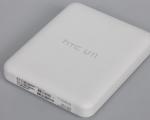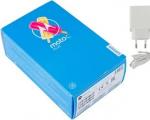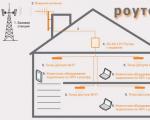Speed up windows 10 system. Check disk for file system errors
We often treat technology as typical consumers, forgetting that it also needs maintenance. It is not surprising that sooner or later the speed of the laptop drops to such an extent that it becomes very uncomfortable to work on it. The possibility of a component upgrade (for example, expanding the amount of RAM) is not always available, and they are not always needed. As a rule, you can improve the performance of a laptop on windows 10 in simpler ways.
What must be done
Any optimization of the computer on Windows begins with "clutter" - that is, the removal of everything unnecessary.
Check remaining disk space
For normal operation of Windows 10, you need to have about 20 GB of free space on the system drive. If you have less, transfer large files to other drives. As a last resort (if nothing can be transferred), empty the Recycle Bin - as a rule, it occupies up to 10% of the volume of the entire disk.
Another reliable option is to use the built-in Windows 10 utility. Open the system settings, go to the "Device storage" section and select the "Free up space now" item. You will see a list of everything that can be safely deleted - select the items you need and do not be afraid of anything.
Disable auto-loading of unnecessary programs
Software manufacturers like to add it to the autoload list by default. Moreover, if this is a normal practice for an antivirus, then some not the most necessary utilities clearly do not belong there.
Open Task Manager. If it opens in a compact view, click the "Details" button. Go to the "Startup" tab. There you will see a list of programs that are loaded after turning on the computer and work in the background. The ones you know can be turned off. If you do not know what exactly this or that program is responsible for, it is better not to touch it.

Defragment your disk
This, of course, is about the system disk. Defragmentation may be required after several months or even years of use, depending on how frequently the files on the drive are updated.
Enter the keyword "Defragmentation" in the search bar and open the disk optimization tool. Select a drive and click Optimize. Even if the disk does not really need optimization, it will not get worse from this process.
What can be optimized in Windows 10?
The interface of "dozens" is very nice, but all this beauty requires system resources. If you donate some features, you can slightly speed up Windows 10 on a laptop.
Disable visual effects
From the "Control Panel" menu, select "System" and open the "Advanced system settings" section. In the "Advanced" tab, open "Settings" (item "Performance"). In the relative tab you will see a complete list of visual effects. Disable those that are not needed - but you can do it all together.
Turn off transparency
The transparency effect of the Start menu can also be sacrificed. Go to Start -> Settings -> Personalization -> Colors. Find the switch responsible for these effects and move it to the left (to the "Disabled" position).
Disable animation
In laptops with budget processors, even such a trifle as window animation affects performance. Turning it off is quite simple: open Settings -> Accessibility -> Display. Move the "Show animations on Windows" slider to the left.
Disable Live Tiles
The Windows 10 menu has been updated with tiles that speed up the launch of programs. But if you do not use them (for example, as a true fan of Windows 7), you can turn them off. More precisely, unpin: just right-click on each and select "Unpin from Start Screen".
What else can be checked?
Many laptops are optimized for long-term use. They may have the appropriate settings activated by default, or something very resource-intensive creates a heavy load and slows down the system.
If the speed drops only at certain times
For example, on Mondays or on the first days of each month. Here the reason is obvious: some process is launched, which takes a large amount of resources. Most often, this is an antivirus - most of these programs are configured to automatically scan the entire computer at regular intervals.
Verification is time and resource intensive - if the amount of disk space is large, it can take all day. Check the schedule for launching antivirus checks - in extreme cases, cancel the automatic start and leave the option to do it manually.
If the laptop is running slowly on battery power only
Most likely, an energy-saving power plan was used. Windows 10 has three different plans: in addition to the above, there are also "Balanced" and "High performance". When connected to a network, performance restrictions are automatically removed, so the laptop can work quite quickly.

If the speed noticeably drops when switching to offline operation, check the power plan (Control Panel -> Hardware and Sound -> Change power settings).
If the speed drops only when connected to Wi-Fi
It is possible that you have cloud storage clients installed. Their default settings provide for synchronization only via Wi-Fi (to save mobile traffic in the case of laptops with built-in modems). Accordingly, as soon as you connect to a wireless network, the synchronization process begins.
 The tenth version of Windows differs in that it already has integrated support for the proprietary Microsoft OneDrive cloud. If you are not using it from a laptop, disable sync. Go to OneDrive, uncheck "Sync all files and folders". Another possible scenario is connecting torrent clients. They also often end up on the startup list and sit peacefully in the background, downloading and distributing files. How to remove them from startup, we wrote above.
The tenth version of Windows differs in that it already has integrated support for the proprietary Microsoft OneDrive cloud. If you are not using it from a laptop, disable sync. Go to OneDrive, uncheck "Sync all files and folders". Another possible scenario is connecting torrent clients. They also often end up on the startup list and sit peacefully in the background, downloading and distributing files. How to remove them from startup, we wrote above.
Useful optimizer programs
Once you've dealt with your current problems, it's time to think about how to avoid them in the future. You can use optimizer programs - they will do almost the same thing that you just did with your laptop: delete temporary files, identify programs that consume too many resources ... And besides, update drivers, fix errors in the registry, and so on .
As a rule, such software has a free trial period, but you are unlikely to feel the result in these 30 days. So the ideal option is to purchase a paid version for a year. For example, the popular AVG TuneUp optimizer costs 1190 rubles. in year.
This question is asked by many users, but very few people know about this possibility. To optimize the process of speeding up your computer, you do not need to be an experienced user, even a beginner can handle it.
Almost all gadgets for visualization, sound and other “useful functionality” were initially included in all operating systems, and in Windows 10 they added user tracking, an absolutely unnecessary function, like many others that slow down the computer’s performance in order to speed up your computer we will discuss disabling some of them.
Windows 10 consumes a lot of resources of your computer (laptop), and if you install it with the average components of your PC, then sooner or later you will face the problem of lack of RAM, for example. In order not to hit your wallet with new parts of your computer, fortunately, you can limit the unnecessary (in your opinion) functionality of Windows 10, because the acceleration of your computer (laptop) depends on its optimization by the user, this article will help you do this.
CUSTOMIZING THE START MENU
Increasing computer performance will depend on what you are willing to sacrifice for this, whether it is appearance or an increase in temperature in the system unit, it does not matter. One of these "victims" are "live tiles". In Windows 10, Microsoft has allowed us to get rid of them, which we will do to speed up the laptop (computer).
To do this, do the following: go to the start menu -> right-click on the tile -> unpin from the start screen, you can use the usual shortcuts on the desktop, which is no less convenient, but in order to bring Windows 10 to maximum performance and this method will do.
DISABLE VISUAL AND SOUND EFFECTS
Disabling visual and sound effects will do little to speed up Windows 10, and I advise you not to. Without them, Windows 10 will look like older versions and will absolutely lose its charm, but I'll cover this little feature anyway. To turn off unnecessary effects, click "start"->options->menu "accessibility"->other options->"play animations in Windows".
You can check for yourself whether it solves it in performance or not by loading the "CPU usage" widget on the desktop and comparing the results before and after switching the checkbox, this can be done after turning off any unnecessary function, in your opinion. Next, right-click on the start menu -> system -> advanced system settings -> advanced -> performance -> settings. By clicking on the option "Ensuring the best performance" all effects will be disabled->"Apply"->"OK".

PROGRAM SETUP IN AUTOLOAD
How to speed up your Windows 10 computer?
The answer to this question is the startup setting, because it is the programs running on the PC that load the central processor, and therefore the entire system, which affects the operation of the PC.
You can have a large number of programs installed on your computer, and not all of them are needed at the current time, therefore, autorun of these programs is absolutely not needed, and we will consider how to remove the "extra".
Press the key combination "Ctrl + Alt + Delete (Del for laptops)" -> "task manager" -> "details"


Customize the startup of applications, disabling programs that you do not need at a given time. To do this: right-click on the application-> "disable". Regular startup checks are necessary, as new applications will be installed, as well as printers, scanners, phones will be thrown, and these are new utilities that will again fall into autorun, and you simply forget about them while the processor is working. This method and others are described in the attached video below. Another way to optimize autorun will be discussed later.
UPDATE WINDOWS 10
As for updates, many people think that constant updates are good, Windows 10 will work better, but no. Microsoft is testing new versions of Windows on technologies that are very different from what we use on a daily basis. They are much faster, more powerful, and updates are released to modify the system for new hardware (parts of your PC or laptop), so I think that windows 10 does not need constant updates and you should stop its auto-update, which is simply uncontrollable, because it could turn on in any time you reboot your system when you need to work on your PC right now.
To disable automatic updates in Windows 10, do the following:
Open the Settings app (hover over to the right corner, at the bottom of the desktop) -> Update & Security -> Windows Update -> Advanced Settings

First, select "Notify me when a restart is scheduled"-> This will prevent Windows from automatically restarting the computer after downloading and installing updates-> turn off the option "Give updates to other Microsoft products when I update Windows"-> activate the "Delay updates" option. When this option is enabled, new updates will not be downloaded and installed for several days or months, with the exception of security updates.
SETTING UP THE ANTI-VIRUS
As for the antivirus, there is only one piece of advice here, if you need performance (system speed), for example, while playing, or working in Visual Studio and similar programs that require RAM, then it would be better to temporarily suspend the antivirus and do not forget to turn it on after finishing work that required system speed. IMPORTANT!!!- if you are simultaneously sitting in a browser, or playing a game from a browser, then IN NO EVENT should the antivirus program be disabled and in no way limit its performance.
AVG PC Tuneup SOFTWARE (similar to "tuneup utilities")
How to speed up your computer with additional programs? In the previous paragraph, we considered setting up an antivirus program, and I did not give advice on his choice, but in this paragraph I will provide it. An excellent system security product is AVG antivirus, its virus database is very wide, but it has a number of other functions (programs in the product), one of which is AVG PC Tuneup. This program diagnoses system errors and fixes them in the background. In it, you can activate the "Turbo" mode, which will increase the performance of programs and games.
So this is one way to control startup programs, to do this, go to the "optimize"-> "deactivate startup programs" panel. The AVG PC Tuneup program can clean up the registry and defragment it (for stable system operation), as well as to speed up the hard drive, it provides the "hard drive defragmentation" function - it redistributes data blocks on the hard drive and provides more space, speeding up the most loading documents and programs. This process is quite lengthy, but I recommend doing it once every 2-3 weeks.
A nice translucent "Start" may well have an impact on system performance, especially if you have an inexpensive laptop with a budget processor. Disabling transparency will free up some of the resources that can be directed to higher priority tasks.
To do this, you need to go to "Start" → "Settings" → "Personalization" → "Colors" and there turn the "Transparency Effects" switch to the "Off" position.
Animation effects, smooth scrolling and various shadows further affect system performance. You can disable all this with just one click.

To do this, open the "Control Panel" (it can be found through the search) and then follow the steps: "System and Security" → "System" → "Advanced system settings" → "Settings" on the "Advanced" tab. Now in the "Visual Effects" section, you need to check "Ensure the best performance."
In the same place, you can simply uncheck the least important effects for you, leaving only the ones you need.

If you don't use Live Tiles in your Start menu, you can opt out of them entirely, as they also use up resources. To clear the "Start", leaving only the list of programs, you need to unpin all the tiles one by one. To do this, right-click on each and select "Unpin from Start Screen".
Notifications from applications and other senders can load the system the first time certain programs are launched, and especially . To turn off all annoying Windows 10 notifications, go to "Start" → "Settings" → "System" → "Notifications and actions" and there turn the top switch to the "Off" position.

Unloading system resources will also allow the rejection of Windows tips, hints and recommendations. You can turn off such assistance in the same section of the parameters just below.
And removing garbage from memory must be done systematically. This is a mandatory procedure to maintain a high level of system performance, especially when there is a shortage of free hard disk space.

Cleaning can be done with third-party programs, such as, or using a standard utility. To launch the latter, you can simply type "Disk Cleanup" in the Windows search and open the proposed option. Next, you only need to note what can be deleted.
If, when you turn on the PC, the system boots for a long time and even after the desktop appears, it continues to think about something, you should check the list of programs in startup. It is likely that there is something that can be removed, facilitating the initial launch.

To do this, open the "Task Manager" with the combination Ctrl + Alt + Del or Ctrl + Shift + Esc, then go to the "Startup" tab. To identify the heaviest components, you can sort the list by the Startup Impact column. It remains to select programs and disable them.
Windows 10 provides a standard tool for finding and fixing problems. With it, it is quite possible to fix some pop-up errors that slow down the entire system.

You can go to such a debugger through "Settings" → "Update and Security" → "Troubleshooting". In the window that opens, start the scan from any section where there were any errors.
If you do not have a top-end computer with the most powerful hardware, it is worth lowering the protection level of yours by prohibiting it from performing a systematic check of PC memory. You can also search for potential threats manually when the computer is not performing other tasks.

Two antiviruses installed on a PC for maximum reliability can exert a particularly high load on the system. Make a choice in favor of one remedy and discard the less useful one.
Windows 10 by default monitors some user actions and sends reports to Microsoft. These background activities cannot but consume system resources, which is especially noticeable on weak computers.

Such surveillance is disabled in the privacy section in the system settings. There you need to turn off the first three functions in the “General” subsection, and also select the main amount of data to send and the frequency of generating feedback “Never” in the “Reviews and diagnostics” subsection.
In the case of laptops, the selected power management scheme can also affect system performance. When operating from the mains, a scheme with high or at least balanced performance should always be selected. The Energy Saver option is designed for offline use of the notebook when it is important to use battery power as efficiently as possible.

You can go to power management through "Control Panel" → "System and Security" → "Power Options".
How to speed up Windows 10 if it has slowed down and slowed down the computer? Make it faster by using the best Windows 10 speed up methods from our detailed guide.
If you're willing to sacrifice security, you can turn off protection against the Specter and Meltdown vulnerabilities found in and get back the old performance.Download the free utility and run it as an administrator. Click the buttons Disable Meltdown Protection" And " Disable Specter Protection", then exit the program and restart your computer.

Protection will be disabled and performance will be restored.

Power setting
Changing your power settings to High Performance is a good choice if you're not used to saving power and want to improve the performance of Windows 10.Follow the following path:Start menu > Settings > System > Power and sleep > Advanced power settings.
Have you still not got a new computer or is an old device used at home to solve issues related to processing text documents and navigating through the pages of the global network? Based on the system requirements that a computer must meet in order to run Windows 10 on it, almost any PC released over the past decade will run the new OS. Another question is what kind of work this will be. We'll deal with him.
hardware requirements
In order to install and run Windows 10, you need 16-20 GB of space on the system disk, at least 1024 MB of RAM + a paging file twice as large. It is difficult to find a central processor with a frequency below 1.1 GHz in our time, and you should not install the "top ten" on such a computer. Even if the OS starts up, then performing the simplest calculations, even to ensure the operation of a browser or an office program on a weak computer, will turn into an unbearable burden for a low-powered processor.
Installing Windows 10 on any weak computer with a single-row (or at least multi-threaded) CPU, whose clock speed does not exceed ~2.4 GHz, is not worth it. “Ten”, although it is the most optimized operating system, still technologies do not stand still, and 10-year-old hardware will not cope with the data streams that circulate in the operating system released in 2015.
As for the drive, an IDE hard drive will only slow down the already lengthy Windows 10 boot process on an old PC, especially with significant disk fragmentation, low RAM, and page file usage.
A video card with a capacity of 64 MB or more will quite cope with drawing elements of the new tiled interface, if you turn off all unnecessary visual effects that heavily load the processor and clog memory.
Based on the official data, almost any computer that supports Windows 7 should also be able to handle Windows 7 due to the optimization of its code.
Recommendations for working in the "tens" environment on outdated hardware
After starting an old computer running Windows 10, there may be problems with drivers, which are often solved using the update center or manually searching for and installing missing or problematic software.
Despite the official requirements, an old laptop, if its processor runs at a frequency below 2.4 GHz (although this is far from an indicator of its performance), and less than 2 GB of RAM is installed on board, the “ten” will pull, but when you start most applications it will be noticed braking, especially if it is a multimedia player, browser or heavier software. Therefore, such a computer is suitable only for solving a single task at a time, and it is not recommended to run several programs on it.
Acceleration "tens"
Despite Windows 10 optimizations, not every processor can handle data from multiple applications. To avoid this, it is necessary. To do this, we call the "Task Manager" and prohibit the download of unnecessary applications with the operating system.
In the "Services" tab, you can disable unnecessary utilities, but only experienced users should do this, being careful.

To improve the performance of your hard drive, you need to defragment the system volume. In the disk properties dialog, go to the "Tools" tab, where we click "Optimize".

In the window that opens, click "Optimize" again and wait for the program to organize the files on the disk.










